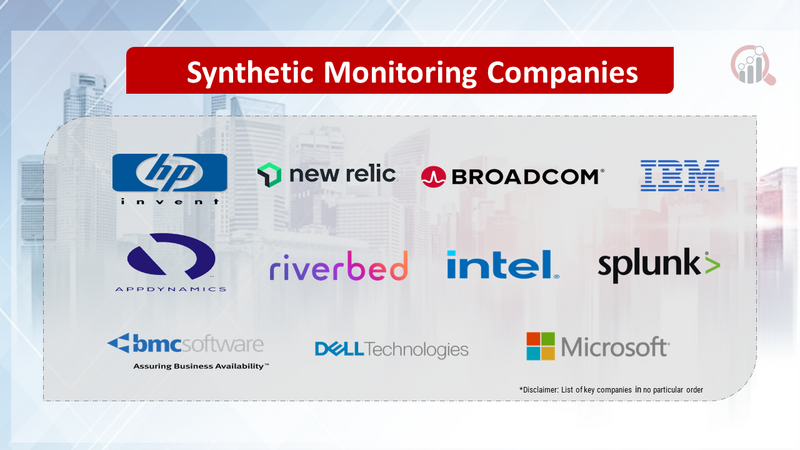Top Industry Leaders in the Synthetic Monitoring Market

Competitive Landscape of Synthetic Monitoring Market
The synthetic monitoring market is a dynamic and rapidly evolving landscape, characterized by a diverse mix of established players and new entrants. In this intensely competitive space, companies are constantly vying for market share through a variety of strategies, including innovative product offerings, strategic partnerships, and aggressive marketing campaigns. Understanding the competitive landscape is crucial for companies looking to navigate this market successfully.
Key Players:
- Hewlett Packard Enterprise Company
- New Relic Inc.
- Broadcom Inc.
- AppDynamics
- IBM Corporation
- BMC Software
- Splunk Inc
- Riverbed Technology
- Dell Technologies Inc
- Microsoft Corporation
- Intel Corporation Amway
Strategies Adopted:
In a bid to gain a competitive edge, companies in the synthetic monitoring market are adopting a range of strategies, including:
- Innovation: Companies are investing heavily in research and development to create new and innovative synthetic monitoring solutions. This includes the development of AI-powered solutions that can provide more comprehensive and actionable insights.
- Partnerships: Strategic partnerships with complementary technology providers are a key strategy for many companies. This allows them to expand their product offerings and reach new markets.
- Acquisitions: Acquisitions of smaller companies with innovative technologies or strong customer bases are also a common strategy. This allows companies to quickly gain market share and expertise.
- Pricing models: Companies are experimenting with different pricing models, such as subscription-based models and usage-based models, to attract new customers and retain existing ones.
Factors for Market Share Analysis:
When analyzing market share in the synthetic monitoring market, several key factors should be considered:
- Product portfolio: The breadth and depth of a company's product portfolio is a key factor in market share analysis. Companies with a wider range of solutions are more likely to capture a larger share of the market.
- Geographic reach: The geographic reach of a company's operations is another important factor. Companies with a strong presence in key markets are more likely to have a larger market share.
- Customer base: The size and loyalty of a company's customer base is also a key indicator of market share. Companies with a large and loyal customer base are more likely to maintain their market position.
- Brand recognition: Brand recognition is a valuable asset in any market, and the synthetic monitoring market is no different. Companies with strong brand recognition are more likely to be considered by potential customers.
New and Emerging Companies:
Several new and emerging companies are entering the synthetic monitoring market with innovative solutions and disruptive business models. These companies are challenging the established players and creating new opportunities for growth in the market. Some notable examples of new and emerging companies in the synthetic monitoring market include:
- Uptime.com: Offers a cloud-based synthetic monitoring solution that is simple to use and affordable.
- Pingdom: A popular website monitoring tool that has recently added synthetic monitoring capabilities.
- Loadimpact: A provider of load testing solutions that has also entered the synthetic monitoring market.
- Monitis: A website monitoring solution that offers a synthetic monitoring add-on.
- StatusCake: A synthetic monitoring solution that focuses on monitoring APIs.
Current Company Investment Trends:
Several key investment trends are currently driving the growth of the synthetic monitoring market:
- Cloud-based solutions: The increasing popularity of cloud-based solutions is driving the growth of the synthetic monitoring market. Cloud-based solutions offer several advantages, such as scalability, flexibility, and affordability.
- AI and machine learning: Artificial intelligence (AI) and machine learning (ML) are being increasingly used in synthetic monitoring solutions to provide more comprehensive and actionable insights.
- APIs: The growing importance of APIs is driving the demand for synthetic monitoring solutions that can monitor the performance and availability of APIs.
- Real-time monitoring: The need for real-time insights into application performance is driving the demand for synthetic monitoring solutions that provide real-time data and alerting capabilities.
Latest Company Updates:
On Oct.04, 2023, Uptime.com, a leading website monitoring and uptime solutions provider, announced a partnership with Logz.io Open 360TM platform, the maker of an innovative observability and security platform, to develop comprehensive website monitoring services. These leaders in website monitoring, full-stack observability and security will bring their service offerings together with an industry-leading integration.
On Sep. 02, 2023, Apica, a leader in synthetic monitoring and observability, announced the acquisition of an observability data fabric startup, LOGIQ.AI. The company also confirmed securing $10M in funding to modernize data management. With the acquisition and financing, the company plans to continue delivering affordable and flexible observability solutions and develop new capabilities in the coming months for enterprise customers.
On Aug. 30, 2023, Netskope launched a Proactive Digital Experience Management (DEM) solution for the entire SASE architecture to enable proactive user experience management by elevating best practices from the current reactive monitoring tools. Proactive DEM includes Netskope's experience management capabilities, including Netskope Borderless SD-WAN, Netskope Intelligent SSE, and Netskope NewEdge global infrastructure.
On May 18, 2022, Apica Systems, a leader in digital performance monitoring, initiated the Apica Partner Program, designed to allow global channel partners to increase the adoption of advanced synthetic monitoring and load testing tools and their integration. The new program helps resellers & MSPs, system integrators, and technology partners increase revenue and accelerate growth.
Apica aims to help partners become highly effective and more profitable in solving the most complex digital performance challenges their customers face. The two-tiered program includes incentives, training, and streamlined contract management across all tiers.












